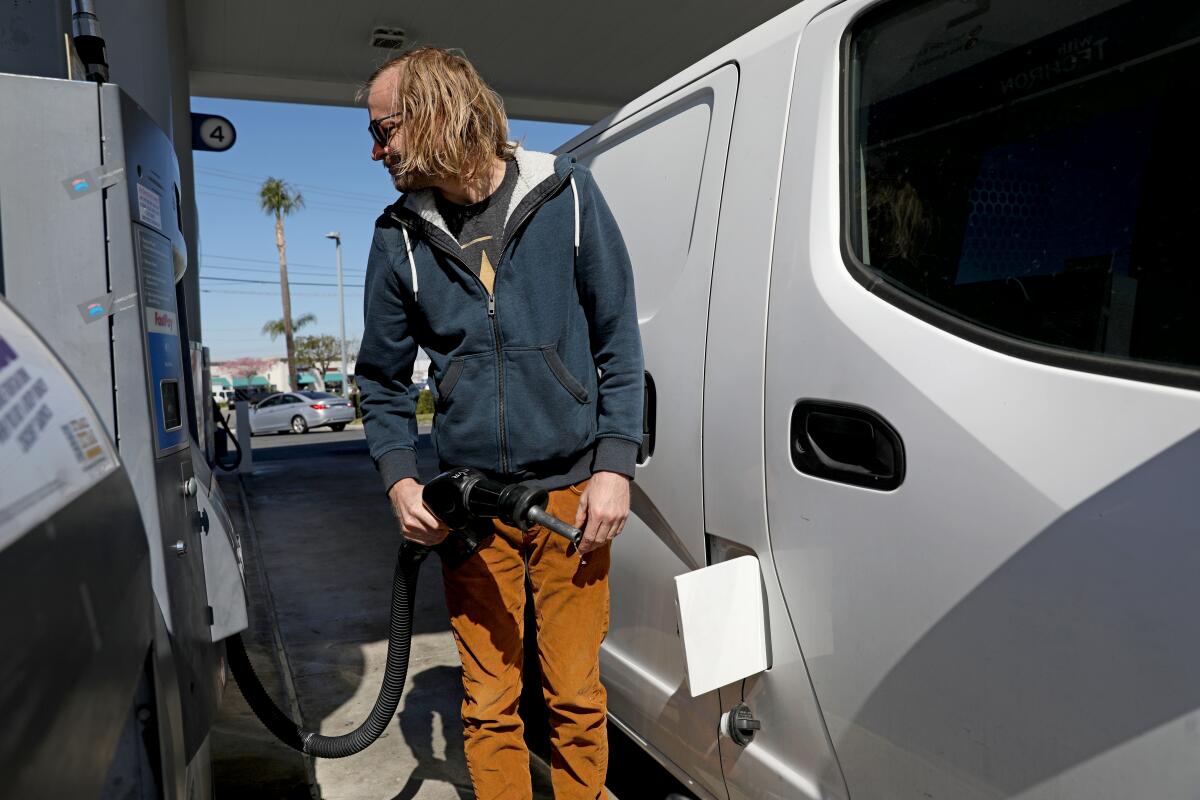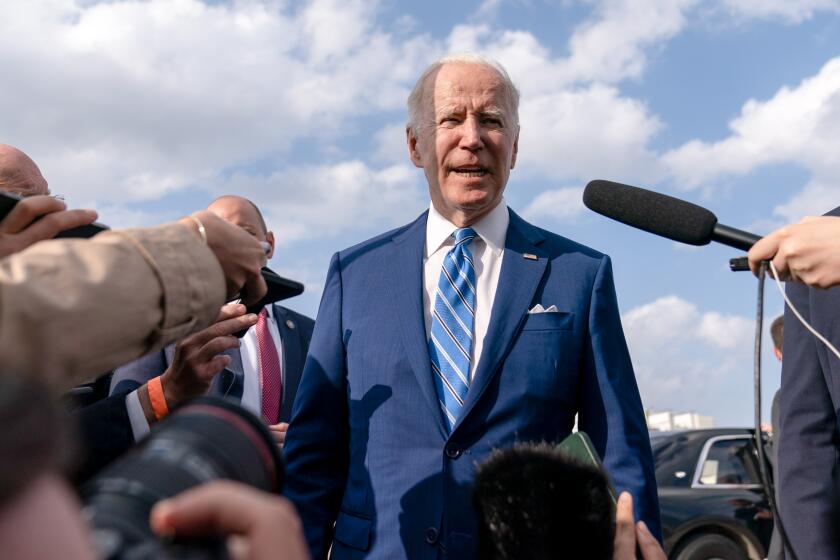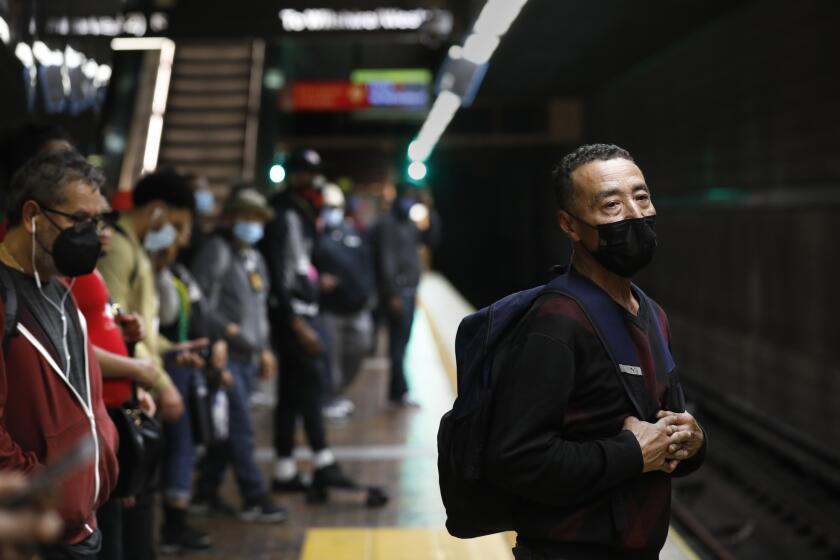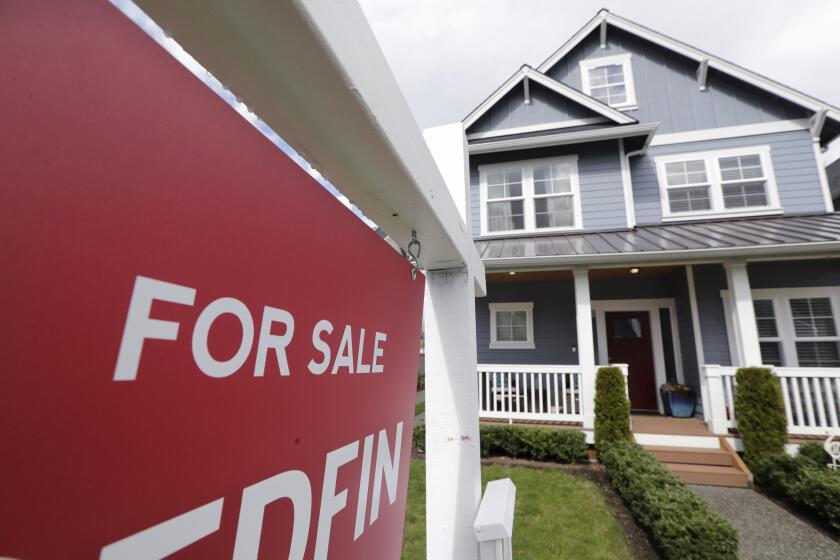California voters say state is moving in the wrong direction, feel financial squeeze

- Share via
Coronavirus cases are dropping and the state’s unemployment rate is on the decline, but most California voters still say the Golden State is headed in the wrong direction, with high gasoline prices, low housing affordability and persistent homelessness cited as the biggest challenges.
In a new survey on some of the most prominent economic topics, nearly 6 in 10 voters said the state is on the wrong track and more than 70% rated high gasoline prices as a “very serious” or “somewhat serious” problem. The survey of registered voters by UC Berkeley’s Institute of Governmental Studies was co-sponsored by the Los Angeles Times.
“Californians are giving a negative rating of the direction of the state,” said Mark Di Camillo, director of the Berkeley institute’s poll. “That coincides with how voters are viewing their personal financial situation.”
In response to the pain at the pump, voters said they are likely to cut back on driving.
Few, however, said they expected to switch to public transit. Only 25% said they were likely to take buses or trains more often.
Voters like how President Biden handled the Ukraine war but not inflation, and his standing is middling in California. Kamala Harris fares less well.
By contrast, 7 in 10 said they were likely to drive less around town or cancel vacations or weekend road trips because of the high prices.
The pain of high gasoline prices, which last month reached a statewide average of $5.73 a gallon — up $1.79 from a year ago, is felt most keenly by lower-income Californians, Black and Latino residents and those under 30, according to the survey.
Among California voters earning less than $40,000 a year, 81% said gasoline prices were a “very serious” or “somewhat serious” problem. At the other end of the income scale, 57% of those earning more than $200,000 said the prices were not a serious problem.
Gasoline prices were described as a “very serious” or “somewhat serious” problem by 79% of Black voters, 85% of Latino voters and 75% of voters under 30, according to the survey.
Lorena Mendez, an airline catering company worker at Los Angeles International Airport, struggles weekly deciding how to fill her tank and buy groceries, among other household expenses. She bought a house in Bakersfield because housing is more affordable there, but her commute to LAX is two hours in each direction. On some days, rather than driving home she stays with her mother, who lives closer to her job, to save on gas.
“Everything has gotten more expensive, gas and groceries,” she said in Spanish. “It’s hard to figure out which bill to pay first.”
Until recently, Mendez said, she earned about $22 an hour, but her bosses have cut her pay to about $18 an hour. She hopes to work extra hours to make up for the pay cut.
“I was barely able to pay my bills, and now with everything getting more expensive, it’s a struggle,” she said.
Gasoline prices have reached record highs in Los Angeles, but convincing tens of thousands of Angelenos to leave their gas guzzlers at home is still a hard sell for many.
For many workers like Mendez who have long commutes, public transit isn’t a viable option. The poll asked voters who said they were not likely to take transit more often to choose up to two main reasons. Among the most common responses were that buses or trains were not convenient either to their destinations (45%) or their homes (35%), that transit takes longer than driving (39%) or that service isn’t frequent enough (20%).
A significant number said they don’t feel safe waiting for or riding on a bus or train (34%) or that they worry about catching COVID-19 or some other illness (16%). Safety concerns were more common in Los Angeles and Orange counties than in the San Francisco Bay Area or San Diego. Few voters — 3% statewide — said transit costs too much.
In 2016, Los Angeles County voters showed just how frustrated they were with traffic. They approved a half-cent sales tax that will pump out $120 billion over four decades to further build out a massive rail system that can carry commuters from the foothills to the sea and to make highway improvements.
The Metropolitan Transportation Authority has already spent $9.2 billion in the last 10 years on transit projects, including a yet-to-open light rail line running from the Mid-City area to the South Bay, a regional connector line and an extension of a line that connects the Westside to downtown L.A. The agency projects it will spend an additional $30 billion on rail in the coming decade and will over the next few decades double the length of its interconnected rail system in the hope that it will lure more commuters across the region.
Academics said voter reluctance about riding transit in response to gas prices was not surprising.
“While gas prices have gone up, most roads and parking continue to be free and plentiful, incentivizing their use,” said Jacob Lawrence Wasserman, research project manager at UCLA’s Institute of Transportation Studies. “And, with transit not given the priority and service to get Angelenos to many destinations reliably, many are left stomaching higher gas prices instead.”
At the same time, by 56% to 35%, voters supported the state’s effort to build a high-speed rail system between Los Angeles and San Francisco that is already expected to be more than three times the original cost estimated when voters approved funding in 2008.
Registered Democrats favored the project 73% to 18%, but Republicans opposed it 66% to 25%. Nonpartisan voters supported the project 55% to 35%.
The glum attitude about the state’s direction was shared, to varying degrees, by California voters of nearly every age group, ethnicity and political stripe. Just over half of Democrats said the state is headed in the wrong direction, and 93% of Republicans agreed with that gloomy assessment.
Only 21% of voters said they were financially better off than they were a year ago, 42% said they were worse off and 34% said there had been no change.
The survey showed voters are pessimistic about the future: Only 21% predicted they will be better off financially in a year, 30% said they would be worse off, and 44% expected no change in their financial situation.
The poll found that voters now rank the coronavirus near the bottom of a list of 15 challenges facing the state, far behind problems such as housing affordability, homelessness, crime, gas prices and climate change.
Over the last week, the state has averaged 2,824 new coronavirus cases, a decrease of 29.9% compared with two weeks ago. The country also seems to be rebounding from the financial blow of the pandemic: The nation’s unemployment rate has dropped to 3.6%, down from a high of 14.7% in April 2020. In California, the unemployment rate is 5.4%, down from 16.1% in May 2020.
But unemployment rates don’t always tell the full story, said Henry Gascon, program and policy development director at the United Ways of California. His group released a study that concluded that as many as 3.5 million households in California — or 33%— are struggling to meet basic needs, including 1.1 million households in Los Angeles County. The problem, he said, is that many workers are employed seasonally in the manufacturing or retail industries.
“It’s not how many people are employed; it’s how well people are employed,” Gascon said.
Mortgage rates in the U.S. hit 5% for the first time in more than a decade, according to Freddie Mac. The last time rates hit 5% was in February 2011.
The high costs of housing, child care and healthcare are also big factors in why so many Californians with full-time jobs are unable to make ends meet, he said.
Rising costs have hurt President Biden politically, even in heavily Democratic California. The poll found that 60% of state voters said they disapproved of the job Biden is doing dealing with inflation, which reached 8.5% in March. Increases in the prices of gasoline, housing and food were the largest contributors to inflation, according to the Bureau of Labor Statistics.
The newest poll did not ask voters to weigh in on the job performance of Gov. Gavin Newsom, but the previous Institute of Governmental Studies survey, in February, found that 48% of the state’s voters approved of the governor’s performance overall, and 47% disapproved. That was a significant drop in support from a survey in September 2020, when Newsom received a 64% approval rating from the state’s voters.
The Institute of Governmental Studies poll surveyed 8,676 California registered voters March 29 to April 5. The poll was administered online in English and Spanish. The estimated sampling error is plus or minus 2 percentage points. Full question wording and topline results are available on the institute’s website.
More to Read
Inside the business of entertainment
The Wide Shot brings you news, analysis and insights on everything from streaming wars to production — and what it all means for the future.
You may occasionally receive promotional content from the Los Angeles Times.















